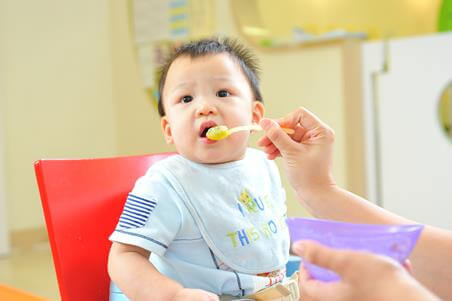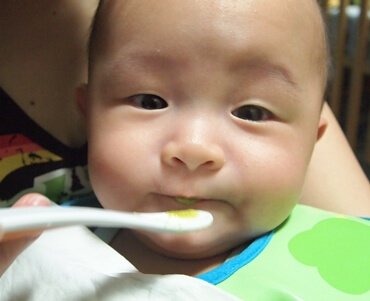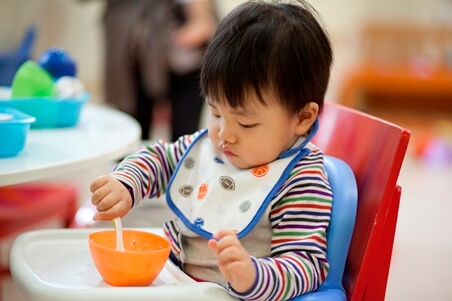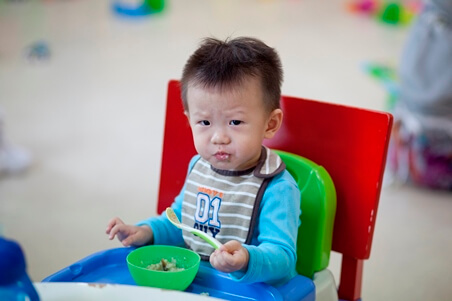Tastes Good, Mom!

You baby is growing bigger and more active by the day and soon, milk alone won't be enough to satisfy him. Weaning, the process of gradually substituting his main meal of milk for other sources of nutrition, encompasses introducing baby to his first foods, a deliciously exciting time for parent and child.
Feeding your baby is a huge responsibility. With his first taste of solids, your child will start to develop food preferences. Good eating habits introduced in the early years will stick with him for life.
WHEN TO START SOLIDS
Try offering baby a first taste of solids when he is around six months old. Although some babies are ready for solids earlier than this, it is advisible to wait until he is at least 17 weeks old. Before then, his gut and kidneys are still too immature to process solid food. His throat muscles are also not developed enough to swallow solids.

It should be noted that the World Health Organization recommends exclusive breastfeeding for the first six months. If you feel your baby is ready for solids at an earlier stage, do discuss this with your pediatrician. Beyond six months of age, your baby won't be able to get all the nutrients he needs from milk alone. From here on, solid food will play an increasingly important part in his diet.
BABY'S FIRST FOODS: PUREES
Most moms start by offering their child baby rice cereal mixed with expressed breast milk or formula. Another popular first-food option is a puree of a single fruit (apple, for instance) or a sweet-tasting vegetable (carrot, pumpkin or sweet potato) mixed with baby's usual milk. Buy a small blender or food processor to be used exclusively for preparing baby's food. In the beginning, your child's food shouldn't be much thicker than milk; it should have a smooth consistency, be easy to digest, and unlikely to cause any allergy.

Annabel Karmel, a popular author of books related to baby food and nutrition, recommends using only sweet fruit (try apples or pears) for baby's first fruit puree. Ensure that the fruit is completely ripe. If you're preparing an apple puree, wash, peel, core and cut the apple into small pieces. Place the pieces in a pan of water and cook over low heat until tender. Alternatively, you can also steam the fruit. Puree the cooked fruit in a blender, thinning it with cooled boiled water, breast milk or formula. Serve it lukewarm by offering baby a small spoonful. If baby takes to the pureed apple, you can try pureed pear next. And as a variation, combine both fruits for a yummy mixed flavour.
Vegetable purees can be prepared in a similar fashion. In her book Feeding Your Baby & Toddler, Ms Karmel recommends a cauliflower or broccoli puree. Steam vegetable florets until tender, drain and blend to a puree. Mix with baby rice cereal and milk (follow packet instructions) and serve lukewarm.
THE FIRST MOUTHFUL
Baby's first taste of solids is a momentous, often messy, occasion. So make sure you pick the right time to spoon in that mouthful. Ideally, baby should be calm, relaxed, and a little hungry. Switch off distractions like TV or radio to focus on the task at hand.
Put a small amount of pureed food on the tip of a shallow baby spoon and wait for baby to open his mouth, giving plenty of encouragement and smiles. Your little one may take a while to get used to the spoon, so be patient and take it slow. Avoid force-feeding. You know your baby has had enough when he pushes the spoon away, clamps his mouoth or cries.
Lunchtime is a good time of the day to serve baby's first taste of solids. Should there be any adverse reactions to the food, you will be able to monitor it throughout the afternoon. Start with one spoon-fed meal a day before introducing a second and a third.
In the event that baby rejects his first taste of solids, don't worry. Simply try again another day.
FEED BABY THIS, AVOID THAT
Below six months: Avoid giving fish, eggs, soft or unpasteurised cheeses or food containing wheat or gluten, as these have been linked to allergies.
From six months: You can give wheat products (bread, pasta), meat, fish, beans and pulses, dairy products such as hard cheeses and baby yogurt. Eggs must be well cooked to avoid the risk of salmonella. Lay off the salt, sugar and processed adult food (like jarred sauces) in baby's meal. Don't give honey as it can cause a form of food poisoning known as infant botulism.
From eight to ten months: Introduce first finger foods such as banana chunks, steamed carrot sticks, chedder cheese sticks or cooked pasta spirals. Make sure the finger foods are soft and sized large enough for your child to hold and nibble on. Remember to supervise at all times when baby is feeding himself. Avoid while grapes as baby can choke on it. At this stage, you can also try making Asian-style porridge, adding carrots, broccoli or chicken and lettin git simmer until the rice completely breaks down and becomes mushy. Blend the cooked porridge to get a smooth puree. Let it cool, then serve.

From twelve months: Honey and lightly-cooked eggs can now be given safely. Salt and sugar may be used, but sparingly. Avoid any kind of nuts as it can be a choking hazard. At this stage, your baby should be eating three main meals a day. He will also be more adept at chewing, paving the way for mashed and finely chopped food. Cubed chicken and flaked fish fillets (check for bones) are just some tasty tidbits that can spice up an older baby's meal.

FOOD NOTES
Faced with so much variety, it is only natural for parents to be anxious about what foods to offer baby. When in doubt, always check with your pediatrician.
When baby becomes more used to eating solids, try introducing more flavours. By giving him a variety of food early on, you're less likely to encounter fussiness at the toddler stage.

Even as parents and caregivers busy themselves with healthy ingredients and cooking methods, prepare yourselves too, for messier than usual mealtimes. Babies may smear food on their feeding chair, rub it in their hair and clithes; they may even fling food around... a little tolerance, a sense of humour and a dish cloth on standby will see you through!
You may also like

From Cabin to Classroom: Journey of an Outstanding Early Childhood Educator
The PDP modules allowed me to get creative with lesson ideas and keep up with the ever-changing Early Childhood sector.

Ms Farhana Binte Mohamed Hassan
Early Years Educator - PCF Sparkletots @ Pioneer Block 987D (CC)

More Than Just a Place for Food
Young children are highly inquisitive, and learn most effectively with activities that allow exploration and experimentation.

Kinderland @ Yio Chu Kang

Little Fingers Create Great Art - A Community Project by Kinderland and Skool4kidz
I believe this collaborative effort is a very meaningful contribution to the SG50 celebrations.

Kinderland and Skool4Kidz